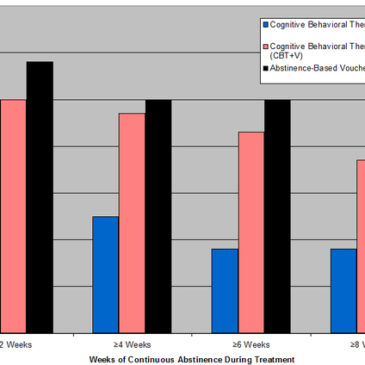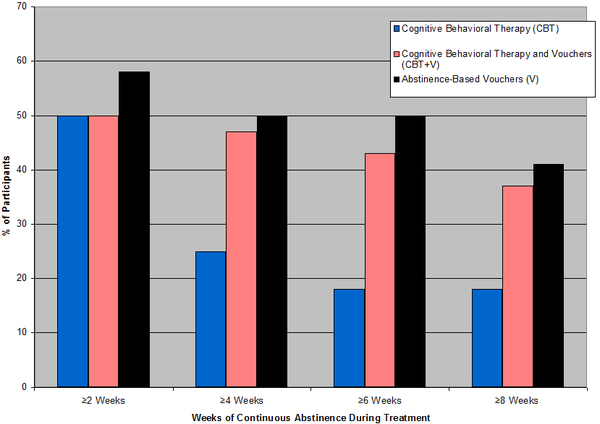During the 1990s, demand for cannabis treatment doubled (Substance Abuse and Mental Health Services Administration, 2001); however, only five clinical trials examining the efficacy of treatment for cannabis dependence have been reported (e.g., Marijuana Treatment Project Research Group, 2004; McRae, J., & Brady, 2003). These studies indicated that although cognitive behavioral therapy (CBT) resulted in abstinence during treatment, relapse rates remained high. During 2000, Budney, Higgins, Radonovich and Novy discovered that adding abstinence-based voucher incentives to CBT for marijuana dependence resulted in significantly greater levels of abstinence than CBT alone among individuals seeking treatment at a university-based outpatient clinic. This week’s STASH reviews a follow-up to Budney et al.’s (2000) study that compared the impact of incentive-based vouchers alone, CBT, and a combination of CBT and incentive-based vouchers on cannabis use.
Budney, Moore, Rocha, and Higgins (2006) recruited 129 cannabis dependent patients at a university-based psychotherapy clinic in Burlington, Vermont between December 1999 and October 2002. Bachelor’s level research assistants screened out 38 patients because they did not meet DSM-IV (American Psychiatric Association, 2000) criteria for cannabis dependence or did not use marijuana during the 30 days prior to the interview. The researchers then randomly assigned eligible patients to three treatment groups: abstinence-based vouchers only (V); CBT only; and CBT+V. V participants met with research staff twice a week for 14 weeks to provide urine samples and completed brief interviews. V participants received a monetary voucher for each marijuana-negative specimen they provided. The initial voucher was worth $1.50 and increased by $1.50 for each additional marijuana-negative specimen. If participants provided a marijuana-positive specimen, the monetary value of the voucher returned to $1.50 and the progression began again. CBT participants received a 50 minute session once a week for 14 weeks and received $5 for each urine sample provided, regardless of the test result, to encourage compliance with the monitoring program. Lastly, CBT+V participants received the same abstinence-based voucher program as V participants and the same number of treatment sessions as CBT participants. Research assistants then conducted follow-up assessments and urinalysis at 3, 6, 9, and 12 months post treatment. The researchers compared between-treatment durations of abstinence with one-way analysis of variance and pairwise contrasts using adjusted means.
Analyses indicated a main effect for treatment type on continuous weeks of participant marijuana abstinence during the treatment period, F (2, 84) = 3.05, p= .05. Figure 1 displays the percent of abstinent participants in each condition for different durations of time. Pairwise comparisons indicated that participants only receiving abstinence-based vouchers reported significantly more weeks of abstinence during treatment than did participants only receiving CBT (p =.02, d = 71). CBT+V engendered more abstinence than CBT alone, but the difference was not statistically significant (p = .20, d = .39); there was no significant difference in resulting abstinence during treatment between CBT+V and V (p = .32, d = .31).
Figure. Duration of Continuous Marijuana Abstinence by Treatment for Marijuana Dependence (adapted from Budney et al., 2006). Click image to enlarge.
Post-treatment pairwise comparisons revealed that significantly larger proportions of CBT+V participants maintained post-treatment abstinence than did CBT participants
χ2 (1, n = 60) = 4.22, p = .04. Additional analyses indicated there were not significant differences in abstinence among pairs of treatments.
The study is not without limitations. First, participants were mostly white males (77%) seeking psychotherapy from a university-based clinic, suggesting that the results might not generalize to more diverse populations. Second, the small number of participants limited the power of the analysis, making it difficult to demonstrate confidently potentially important differences between CBT and CBT+V. Third, although a significantly greater percentage of V participants than CBT+V participants maintained abstinence during treatment, the small effect size indicates only minor distinctions in treatment outcomes.
Findings from this study indicate that abstinence-based vouchers, with or without additional CBT, serve as an effective intervention for cannabis dependent study participants. Further examination of treatment combinations is warranted because less than half of participants maintained abstinence for more than two weeks post treatment. Moreover, this study only reports abstinence rates. A report describing the treatment effects on amount and frequency of cannabis use post-treatment would be interesting and potentially useful.
What do you think? Please use the comment link below to provide feedback on this article.
References
American Psychiatric Association. (2000). DSM IV-TR: Diagnostic and statistical manual of mental disorders–Text revision (Fourth ed.). Washington, D.C.: American Psychiatric Association.
Budney, A. J., Higgins, S. T., Radonovich, K. J., & Novy, P. L. (2000). Adding voucher-based incentives to coping-skills and motivational enhancement improves outcomes during treatment for marijuana dependence. Journal of Consulting and Clinical Psychology, 68, 1051-1061.
Budney, A. J., Moore, B. A., Rocha, H. L., & Higgins, S. T. (2006). Clinical trial of abstinence-based vouchers and cognitive-behavioral therapy for cannabis dependence. Journal of Consulting and Clinical Psychology, 74(2), 307-316.
Marijuana Treatment Project Research Group. (2004). Brief treatments for cannabis dependence: Findings from a randomized multisite trial. Journal of Consulting and Clinical Psychology, 72, 455-466.
McRae, A. L., J., B. A., & Brady, K. T. (2003). Treatment of marijuana dependence: A review of the literature Journal of Substance Abuse Treatment 24, 369-376.
Substance Abuse and Mental Health Services Administration. (2001). Treatment episode data set (TEDS) 1996-1999: National admissions to substance abuse treatment services Rockville, MD: U.S. Department of Health and Human Services






alex0629 August 30, 2008
It has been seen that with treatment and support from family and friends, a lot of addicts have been able to give up this addiction and they rebuild their lives. But it is a very poignant fact that there are still some addicts who are not able to stop this addiction in spite of many helps. Many Alcohol Rehab are providing good programs to remove these types of disease from our society.